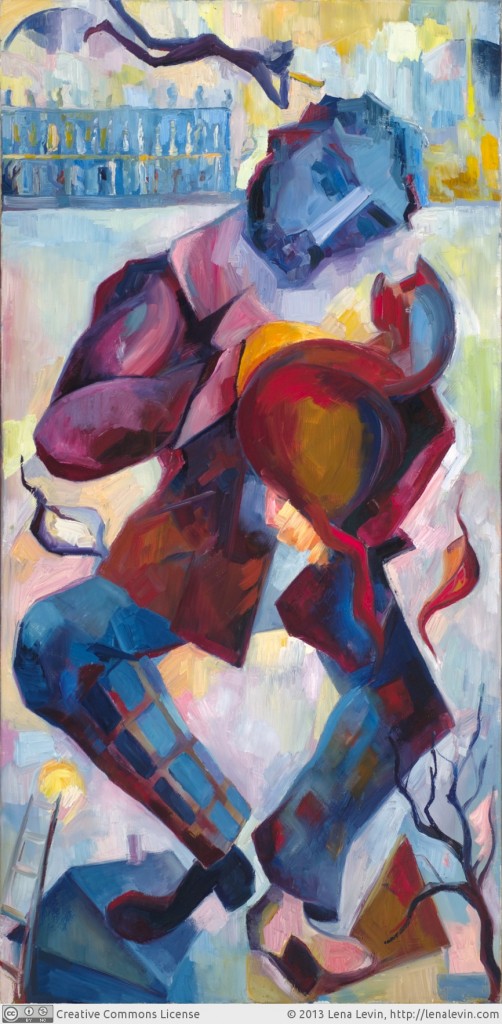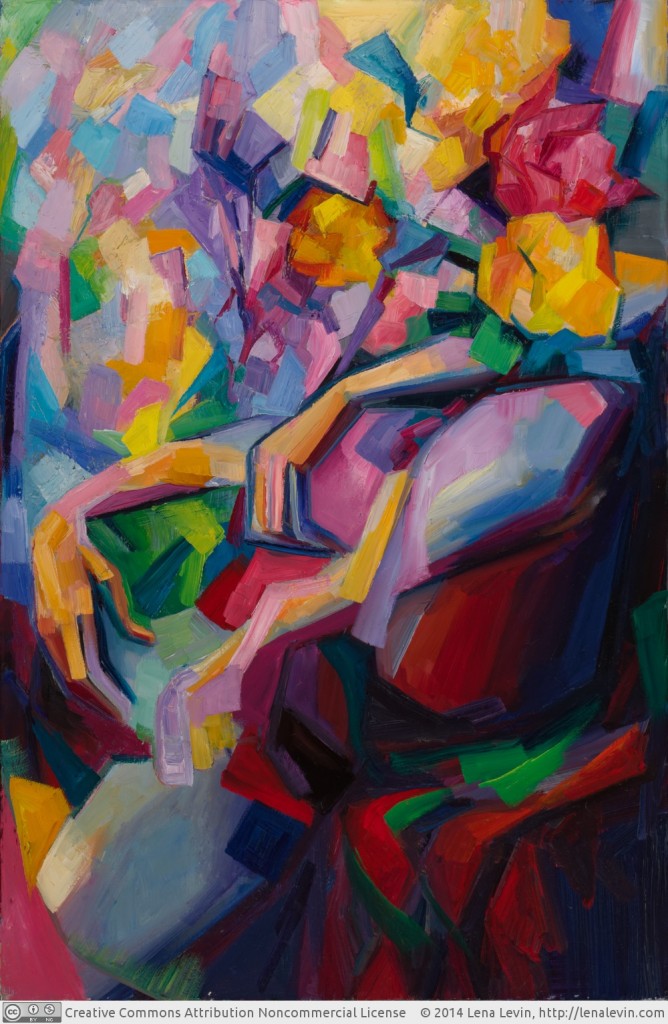
Every once in a while, usually after reading someone’s excited blogpost, I decide that I ought to read “The Artist’s way” by Julia Cameron, but invariably get dissuaded by Amazon reviews (both positive and negative alike). The most recurrent complaint, it seems, is the overwhelming abundance of references to God in the book, which seems to frustrate even moderately religious readers, let alone non-religious ones.
Michael Atavar’s little book on “12 rules of creativity” deals with the same problem — creative blocks, and how to find one’s way through them — but without any references to God whatsoever. To be completely honest though, I must add this qualification:
At one point Atavar recounts a story of calling upon Carl Gustav Jung for guidance about his book, presenting him (Jung) with several options and using dice to get in touch with him, “as a kind of psychic telephone”. “Was the book, — Michael asked,
(1) a bird,
(2) a ladder,
(3) a floor,
(4) an eye,
(5) a cliff, or
(6) a fast car?”
and rolled the dice. “Carl’s reply was: (1) a bird.” This DIY augury is the closest the book gets to gods (one is tempted to add “There is no God but the collective unconscious, and Jung is its prophet.”)

This story illustrates nicely one of Atavar’s twelve rules, which reads:
Randomise!
That is to say, try and get some random answers to your dilemmas, and see where they take you. He writes:
“The throw of the dice can help to legitimise decisions by us that feel intuitively correct, but can’t be justified by any other means. In fact, we have to fool ourselves in this way to give credibility to our innate choices.”
Seeking randomness is but one way to let go of the idea of control, of the artist’s complete authority over their “output”:
“In reality, you have little control over your creative output. Of course you can add systems and processes etc. just as we have discussed in this book, but really you have no chance to change anything. Sometimes it’s good to remember this fact.”
Indeed, the last (but certainly not least) rule in the book is:
Lose the ego!
That’s easier said then done, of course, but Atavar does offer some tips on how to do it (including working in a (real) group context, mentally communing with imaginary collaborators, both dead and alive, and — when all else fails — sleeping).
So what are other rules (which aren’t really rules, but processes and procedures for getting through blocks)?
First, there is a group of ideas which seem more or less self-evident for a painter (at least if their practice isn’t limited to Abstract Expressionism):
Open your eyes!
Use images!
Use colour!
Copy nature!
Check-in!
These five practices overlap, but “Check-in!” is more general than “Open your eyes!” and stands for being present in the moment (as opposed to “checked-out”). And all these injunctions are understood way more broadly than in a “traditional” painting practice. “Copy nature”, for example, doesn’t mean (just) painting or drawing from nature, but rather letting your ideas evolve in a way that would resemble nature (a flower, after all, creates itself effortlessly, drawing nourishment and energy from its environment and following the cycles of the world around it; it doesn’t seem to have “creative blocks” — so, just try and do the same thing). Still, I believe these are ideas and procedures that come more naturally to a painter whose practice is grounded in direct observation of the world around them than to artists working in other mediums, genres, and styles.

Then, there are two “rules” which address the issue of creative block head-on:
Develop failure!
Converse with blocks!
The first of these subsumes several disparate ideas, like accepting blocks as a necessary part of the process, amplifying what looks like failure, and imposing additional arbitrary limits on your practice. The second, on the other hand, means just what it says:
“Talk to the block. Allow it the space that was previously denied. Destroy all sense of difference between “you” and “it”, so beginning a useful dialogue.”
And finally, there are two rules which might seem like opposites, but both have to do with being more childlike:
Play!
Do the opposite!
When Atavar says “Play”, it’s meant literally: get on the floor, like a child, and play with toys for ten minutes at least. In fact, he suggests the reader makes a contract with themselves to “commit to 10/20/30* minutes of play each day for 30/60/90* days (*Delete as appropriate)”.
(I might try this one, even though there is something definitely un-childlike in the very idea of “contract”).
And here is the idea behind “doing the opposite”:
“The life of the artist is about using the reverse of what’s normally present, making something no one else can see. If everyone is looking one way, at one particular thing, one problem, you need to look in the opposite direction, at contrary things.“
The main motive of the book, present in one or another way in all individual chapters, is that one should “tune in” to something larger than self and shake one’s self out of the delusion that it plays the lead in the whole endeavour. The relevance of this idea is by no means limited to people who call themselves artists. Atavar writes:
“Our adult lives often move us into a position of stasis, where nothing new can emerge. Creativity can give us the freedom to challenge this feeling of inevitability: a lack of purpose, scaled-down expectations, a limited worldview.”
So, artist or not, if you feel stuck in this inevitable and inescapable adulthood (and dislike this sensation), this book might be for you… And in any event, being an artist (that is, producing some artistic “output” professionally) is but one path to the core of creativity:
“We have this idea that creativity must be a product — a book, a performance, an event. I believe that creativity is a process. It might result in some of these external things, but its main purpose is to develop an attitude within ourselves. Self-reflection is the goal of the creative process. We are the output.”
I tend to agree with this view: the ultimate goal is creating ourselves, not artworks or anything like this. And artists are as liable to this stagnation of adulthood as everyone else. The only difference is that the stasis is more obvious if you are an artist — it’s not only inside you, it is for all to see in your output (or lack thereof). Whether it’s a bonus or a curse, I am not so sure.
But there is a broader issue here than just the similarity between the artist’s “creative blocks” and everyone’s stasis of adulthood. It is the problem of isolated “self” (or “ego”, or “consciousness”) which feels itself, at the same time, “in control” and utterly helpless, imprisoned within the skull yet trying to rule the world.

Artists might feel this conflict more painfully, because of the pervasive modern discourse of art as “self-expression”, which seems to imply that the source of their artistry must be located somewhere within the self, or at least within the same skull. In reality, though, it looks like this very “self” is the block with which it attempts to struggle.
The unavoidable reality is that the self, this little “I” of our consciousness, has a very limited view of the interactions between its own body and its senses and the “outside” reality. Our brains work tirelessly, filtering all sensory input and binding the results into this “adult”, “coherent” picture, which is then presented to the consciousness — much more coherent and simplistic than the reality could ever be. It is this fixed and familiar picture that Atavar’s tips and exercises are intended to shake a bit, to allow for some new input from the real world outside, some novel vision. He writes:
The picture I have in my head is of the portable radio. Using this small, sympathetic device we can tune into the phenomena of the world, turning the dial through the spectrum in order to find inspiration. Tune in to allow the free-flowing nature of ideas to develop.
In the end, the essence of this approach to creativity might not be that different from what Cameron tries to express with her references to God — except one doesn’t need to believe in any divine wisdom behind the reality, just accept and enjoy its beauty, messiness, and unfathomable complexity.
[share title=”If you’ve enjoyed reading this post, please consider sharing it with your friends!” facebook=”true” twitter=”true” google_plus=”true” linkedin=”true” pinterest=”true” reddit=”true” email=”true”]
[content_band inner_container=”true” no_margin=”true” padding_top=”5px” padding_bottom=”5px” border=”horizontal” bg_color=”#ddb57a”] Related posts:[/content_band]
-
The Magpie, or how Claude Monet has changed our sense of vision
-
Stephen Greenblatt on Shakespearean Beauty